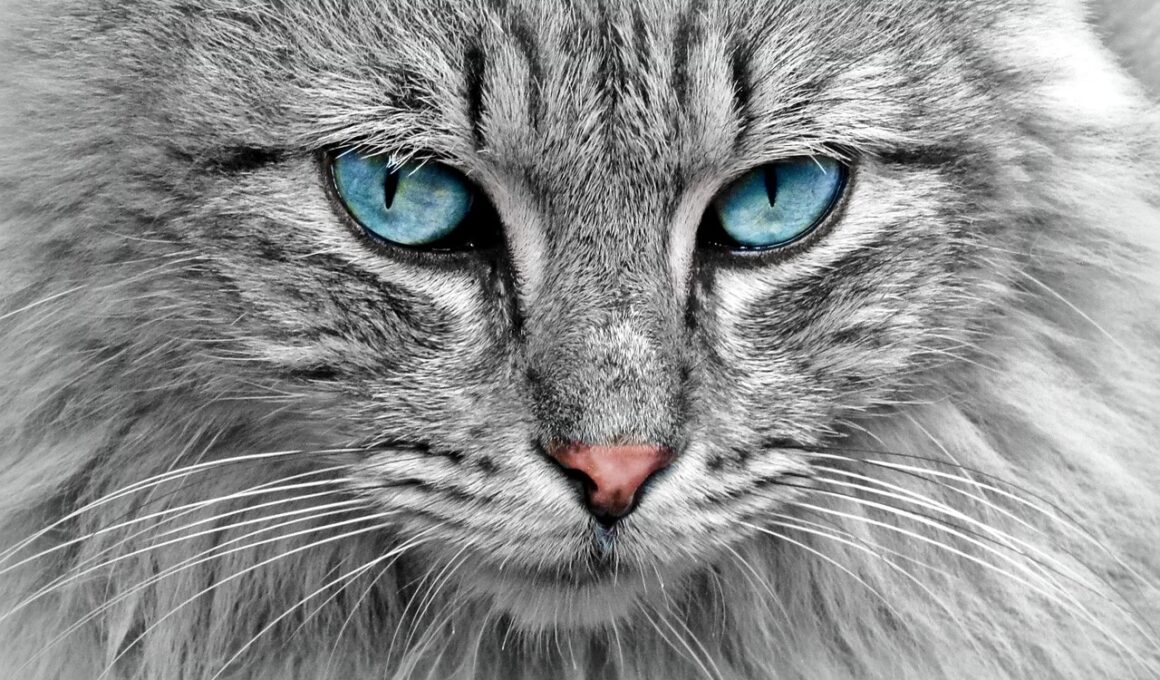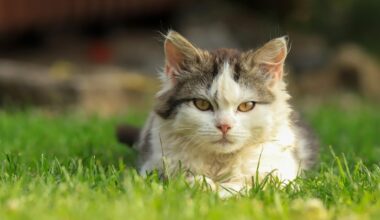Understanding the Social Behavior of Domestic Cats
Domestic cats exhibit a complex social behavior shaped by both their evolutionary history and their environment. Understanding the ethology of these pets requires observing how they interact with humans and other cats. Cats are known for their independence, but they can also form strong bonds with their owners and cohabiting cats. These bonds often resemble those found in social animals, exhibiting the possibility for companionship beyond mere survival. Social interactions often include rubbings, grooming, and vocalizations. Social structure may depend on factors such as household size and presence of other pets. They use body language extensively, such as tail positioning and ear orientation, actively engaging to communicate intents and feelings. Furthermore, cats display behaviors like kneading and purring, indicating contentment and bonding. Recognizing these signs is crucial for understanding feline emotions and social needs. Proper socialization can help reduce behavioral issues, enhancing the human-cat bond. Moreover, it is essential to offer a stimulating environment, as boredom can lead to stress. This is particularly evident in multi-cat households where competition for resources can influence social dynamics. Examining these facets of cat behavior yields essential insights into their happiness.
Life in a Multi-Cat Household
The dynamics of social behavior in multi-cat households can provide fascinating insights into feline ethology. When living with multiple cats, each member typically displays unique social structures and hierarchies. Cats often establish their territories with scent marking, using glands located in their cheeks and paws. This territory marking, alongside grooming behaviors, fosters social relationships. Dominance hierarchies are common, where more confident cats may assert themselves over timid counterparts, possessing the ability to influence seating arrangements and resource access. However, not all interactions are adversarial; relationships can be characterized by mutual grooming, signaling trust and social cohesion. Additionally, vocalizations are significant; variations in meowing, hissing, and purring all serve distinct purposes in communication. It is important for owners to observe and understand these interactions as they occur, diversifying spaces and resources to minimize competition. Failure to recognize and adapt to these social interactions can lead to stress and anxiety among cats, manifesting in undesirable behaviors. By facilitating a harmonious environment, allowing for personal space while encouraging positive social behaviors, owners can significantly increase the well-being of their feline companions.
Cats also exhibit different social behaviors depending on their upbringing and early interactions. Kittens learn essential social skills from their mothers and littermates, providing a critical foundation for future interactions. These skills include how to play, communicate, and even socialize with humans. Socially well-adjusted kittens tend to have positive dispositions as adults, aiding their bonding with families. In clicker training or social play settings, responsive behavior reinforces affection and trust between human caregivers and cats. It’s worth noting that certain breeds may also exhibit heightened sociability, such as Siamese or Ragdoll cats, which often thrive in interactive environments. In contrast, cats that are not socialized early can develop anxiety or aggression, making them less suited for family life. For owners, adapting to individual cat personalities is crucial. Understanding the nuances of these interactions requires observation, patience, and informed action, such as introducing slow acclimatization. Encouragement through play and reward-based training can foster social growth in adult cats, creating a healthy family dynamic where cats feel secure and valued, improving their overall happiness and well-being.
Understanding stress signals in cat social behavior is paramount for ensuring their well-being. Cats can be sensitive creatures, often responding adversely to changes in their environment. Increased anxiety levels manifest through behaviors such as excessive grooming, hiding, or aggression towards other pets. It is essential to recognize individual stressors that may provoke these reactions, such as loud noises or disruptive changes in the household. Each cat has its preferred way of coping with stress; some may seek solitude, while others may become more vocal. Providing a space for retreat and encouraging play can alleviate stress. Owners can facilitate a more relaxed environment through enrichment activities, like puzzle feeders or climbing structures, which engage a cat’s natural instincts and help soothe worries. Moreover, creating a familiar routine can also ease stress by fostering a sense of security. Understanding a cat’s body language is vital to differentiate between relaxed and stressed states. Monitoring food intake and litter box habits can also be informative. This proactive approach to stress management enhances social connections and contributes positively to overall cat behavior. Recognizing signs of stress allows for timely interventions, improving health and happiness.
The Role of Play in Socialization
Play is a fundamental aspect of social behavior in kittens and adult cats. It plays a crucial role in developing hunting skills, communication, and social boundaries. Kittens engage in interactive play with siblings to practice stalking, pouncing, and capturing, mimicking predatory behaviors seen in the wild. This play is essential as it contributes to their physical development and helps them understand social dynamics within their feline groups. In homes, cat owners can replicate this by engaging their cats in varied play sessions, using feather wands or laser pointers, which encourage exercise and stimulate mental acuity. Besides, playtime fosters positive bonding experiences between owner and cat. Adult cats also benefit from playful interactions. Although they may not engage as frequently as kittens, adults exhibit play behavior, showing that the instinct remains throughout their lives. Social play also promotes peaceful coexistence in multi-cat households, alleviating tensions by providing a constructive outlet. Owners should observe play behaviors to ensure safety and enjoyment, adjusting the environment to prevent conflicts. Over time, established routines surrounding play can significantly enhance mutual trust and provide enjoyment for both parties in the human-feline relationship.
The diversity in cat communication strategies is an important factor in their social behavior. Cats use a complex combination of vocalizations, body language, and scent marking to convey their feelings and intentions. For example, a cat may use a soft, low-pitched meow to communicate with humans but may switch to hissing or growling when threatened. Body language reveals a lot; raised tails signify confidence, while flattened ears may indicate fear or aggression. Each communication aspect serves specific purposes; scent marking, when a cat rubs its face against objects or people, reinforces territory claims and promotes social bonds. A cat’s ability to understand these signals enhances interactions with its environment and companions. Observing cat behavior provides insights into their emotional states, helping owners respond appropriately. Improving communication understanding can alleviate behavioral issues, enhancing harmony within multi-pet households. Training cats to respond to cues or commands can also improve the bond between pets and owners. Socialization efforts tailored according to communication preferences can significantly enhance mutual understanding, allowing for a more fulfilling relationship between cats and their caregivers throughout their lives.
Conclusion: Building Positive Social Relationships
In conclusion, understanding the social behavior of domestic cats is vital for enriching their lives and strengthening human-feline bonds. Through observing their interactions, recognizing stressors, and providing opportunities for social play, we are better equipped to meet their emotional needs. Each cat has a unique personality shaped by genetics and individual experiences, making it essential to tailor socialization efforts accordingly. Developing positive relationships involves creating an enriching environment conducive to exploration and interaction, prioritizing playtime, and understanding signals of comfort and stress. Establishing routines can significantly benefit emotional well-being, ensuring that cats feel secure within their environments. Communication is central; understanding the nuances of vocalizations, body language, and social signals enhances our ability to respond effectively. Taking a proactive approach to cat care, stressing social interactions as fundamental, can significantly prevent behavioral issues. By fostering an accepting, understanding atmosphere where reliance and affection thrive, we pave the way for happier, healthier cats. Ultimately, the time and effort invested in understanding and nurturing their social behavior reflect positively on the lives of both cats and their human companions, fostering genuine companionship.


